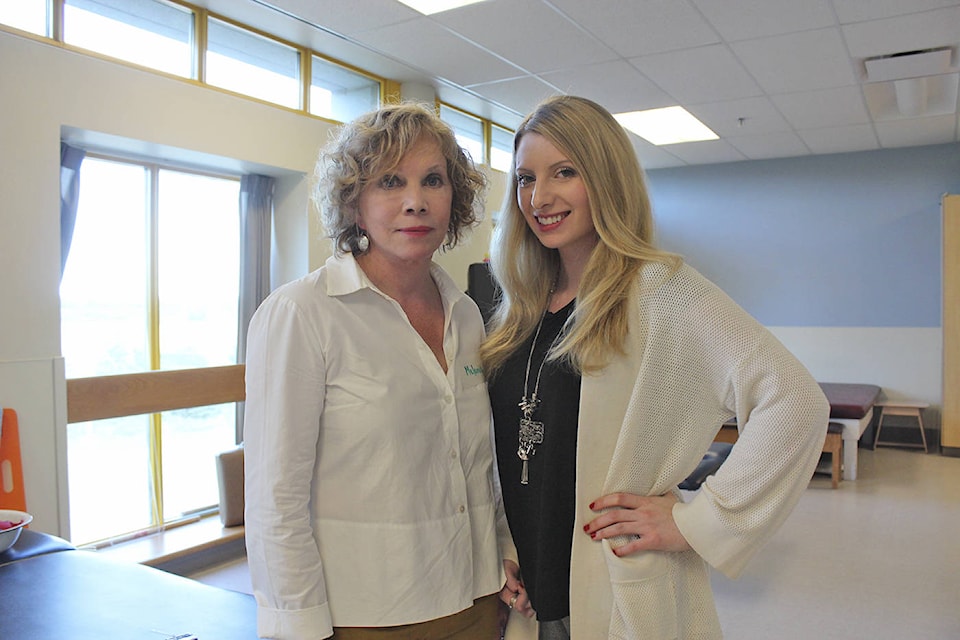In the summer of 2010, Gwendolin O’Connor had everything going for her.
She was on the honour roll at St. Michael’s University School, worked at Thrifty Foods, was on a rowing team, volunteered at a seniors home and had already starting making plans for university. Life seemed perfect to the 16 year old.
But that all came crashing down one day. O’Connor had just passed a lifeguard course and went to bed, when she woke in the middle of the night, and couldn’t stand or move her entire right side. When she tried to call for help, no words came out.
Her mother, Melanie, eventually found her and called 911.
“I didn’t know what was wrong, but I knew something bad was going on,” Melanie said.
Shortly after, O’Connor passed out and went into a coma. O’Connor suffered a stroke caused by an aneurysm bleed in her brain. She underwent two major surgeries, one of which was to remove part of her skull to alleviate the pressure on her brain.
When O’Connor woke her right arm and leg were blue and ice cold. As a result of the stroke, O’Connor couldn’t speak, read, write or spell. Even simple math like one plus two was a strange concept to her. She was diagnosed with aphasia, a communication disorder that results from damage to part of the brain and affects its ability to retrieve speech and understanding of language. She was also diagnosed with apraxia, a motor disorder in which one has difficulty performing tasks or movements.
“My mind felt hollow and empty,” O’Connor said. “My legs, my mind, my voice, everything was gone.”
O’Connor’s long road to recovery began when she was transferred from the ICU to the 5 North neuro-rehabilitation unit at Victoria General Hospital.
It was here she started rehab, and after six weeks in the ward, was transferred to GF Strong Rehabilitation Centre in Vancouver for further rehab services, and slowly began walking again.
During her recovery, everything took longer – typing, tying her hair in a pony tail, lacing up her shoes, or getting dressed. Eventually, relearning everything took a toll on the teenager and after months of rehab, O’Connor hit a wall.
While she was improving, her life revolved around therapy. She was exhausted, self-conscious and ashamed of her new disabilities. It was only after another seizure put her in the hospital that she decided she wanted a new outlook on life.
“I wanted a sense of positivity and purpose. I said to myself, ‘suck it up.’ No more crying, no more embarrassment at my body or my speech. As soon as I made that decision, everything began to improve,” O’Connor said.
Now at the age of 23, O’Connor continues to go to physiotherapy and speech therapy, and is working on regaining movement in her right hand. But she’s come a long way in the last seven years. O’Connor is an A student at Camosun College, a member of a local toast masters group and is a board member with Move, a gym for people with disabilities.
O’Connor is one of dozens of patients who were reunited with staff of the neuro-rehabilitation unit earlier this week. The 22-bed unit includes physiatrists, hospitalists, clinical nurse leaders and educators, speech language pathologists and support personnel, among others.
Dr. Paul Winston, medical director for rehab and transitions for Island Health, said the reunion allowed patients to reconnect with the staff that helped nurse them back to health, and was a chance for patients to connect with other people who have gone through similar experiences.
“For me, what’s important when it comes to a reunion is to celebrate people’s successes and understanding that not everybody has a complete recovery, that a lot of them will continue to live with disability,” said Winston, noting there are roughly 600 patients who receive specialized neuro-rehabilitation at the hospital every year.
“There are some people I saw who were delirious in the ICU, unable to recognize their name, stand or sit,” he said. “Seeing some of them now looking absolutely normal, where nobody would know something happened is really exciting.”



